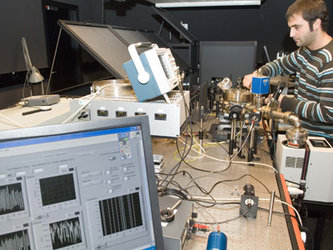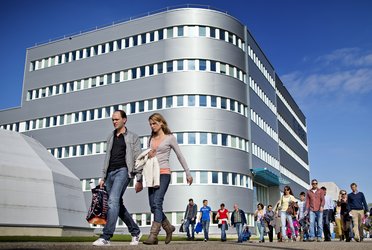How is the Opto-Electronics laboratory equipped?
The Laboratory's current emphasis is on characterising laser beams and other optical signals. It includes a Class 10,000 (ISO 7) clean room, two fully equipped optoelectronics laboratories designed for the operation of Class 4 laser systems (defined as powerful enough to burn skin, cause permanent eye damage or ignite flammable material), workshop and storage rooms. It has the equipment necessary to measure the optical spectrum, beam profile, power and energy, stability and modulation response, in free space as well as optical fibres. Additional measurement possibilities are added as needs arise.
Wavelength and spectrum –The absolute wavelength and optical spectrum of the device output can be measured using standard in-house instrumentation including a high-accuracy wavemeter, Fabry-Perot scanning interferometers and a miniature grating spectrometer.
Power, intensity and frequency response – Laboratory engineers use a range of detectors, power and energy meters to measure the power and energy properties of continuous wave and pulsed light sources, from which emitter efficiency and input-output curves can be derived.
Beam profile and divergence – Beam quality is a key factor for the vast majority of laser applications. All aspects of the beam are measured, for example the near-field and far-field profiles, beam quality and astigmatism. This is done with either an optical train or Shack-Hartmann grating with an accompanying charge-coupled detector (CCD).
Laser-induced contamination and damage – The aim is to characterise contamination on optical surfaces within the laser vessel as well as identify energy thresholds after which damage occurs. Tools in use include cooled CCD camera to monitor the fluorescence emitted by the contaminated optical components and a scatter probe for LID.
Optical coatings spectral shift – During the air-vacuum transition optical coatings suffer a spectral shift, which can lead to significant change of the coatings performance. This phenomena varies depending of the coating manufacture technique. It can be characterized using an adequate light source and spectrometer.
Fibre optics and sensors – Most of the instruments described can also be coupled to fibre systems. The Laboratory has a tuneable laser in the near-infrared coupled with a scanning wavemeter, to provide detail on fibre-optic components or systems.
Mobile lidar – A four detection channel raman lidar installed in a van, used for monitoring atmospheric aerosols and cloud patterns. Equipped with a class four laser power emitter reaching up to 50 km in height.
A Laser Diode Test bench currently in development will offer endurance testing and characterisation of high- and low-power laser diodes.










